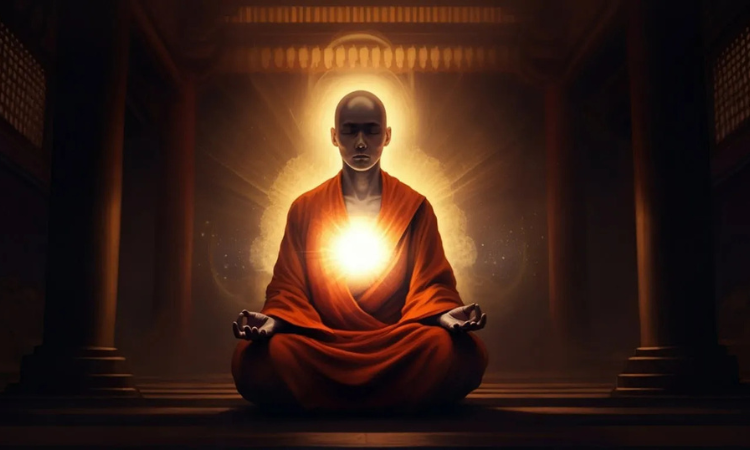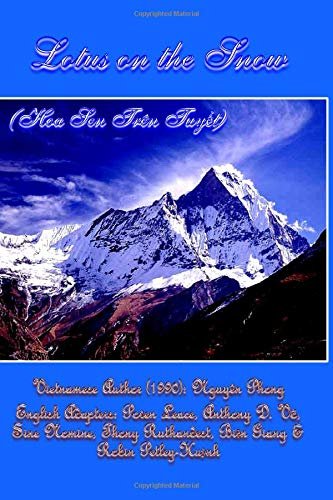Lotus on the Snow – The Hidden Path Few Dare to Walk
Lotus on the Snow: Some books whisper. Others shout. Lotus on the Snow doesn’t do either. It waits.
For the true seeker—one who senses that life is more than survival, more than success—this book opens not with answers, but with presence.
Written by the enigmatic Poven Leace, Lotus on the Snow is not just rare—it is spiritually untamed.
It doesn’t spoon-feed. It stirs. It disrupts.
At first glance, you might mistake it for a simple narrative. A poetic reflection.
But slowly, the reader begins to realize: this book is alive.
It reads you. It awakens questions that were buried under years of noise.
And unlike other spiritual texts that explain or instruct, this one invites you into an experience—a direct, inner remembering.
Its tone and mystique feel unmistakably connected to Baird T. Spalding’s Life and Teachings of the Masters of the Far East.
In fact, many have speculated that Poven Leace may have been a pseudonym or spiritual successor to Spalding himself.
Whether that’s true or not, the feeling is there: that same ethereal light, that same simplicity that holds cosmic weight.
But Lotus on the Snow goes even further.
It dares to strip everything down—concepts, names, structures—until only pure being remains. And that’s why this article is not just a review.
It’s a study. A pilgrimage.
Together, we’ll explore the core ideas, the metaphors, the paradoxes.
We’ll draw lines to other sacred teachings—from Vedanta to Taoism, from mystic Christianity to modern quantum thought.
Most of all, we’ll uncover the practical keys hidden within, so you can begin to live this wisdom today.
Because if this book is anything, it is a call. Not to read more. But to become more.

The Mystery of the Author and Origins
Who is Poven Leace?
Ask the question, and silence answers. No biography. No website. No interviews. Only the book.
That alone speaks volumes.
In a world obsessed with personalities and platforms, Lotus on the Snow arrives with no authorial ego.
It exists like a monk in a cave—unconcerned with being known, but powerful in presence. This anonymity isn’t a flaw. It’s a feature.
It reflects the teaching itself: the truth doesn’t come from a person; it comes from within.
Yet the mystery deepens when we consider the style, tone, and spiritual precision of the book.
Readers familiar with Life and Teachings of the Masters of the Far East often sense a thread connecting Poven Leace to Baird T. Spalding.
Some even believe Leace was Spalding writing under a new name.
Others see it as a continuation of the same spiritual current—a hidden lineage carried by those whose mission is not fame but awakening.
Regardless of authorship, the essence is familiar. It’s not about doctrine or belief. It’s about direct realization.
Interestingly, this kind of hidden authorship is not unique in the history of spiritual literature.
The Tao Te Ching, for instance, is attributed to Lao Tzu—a figure whose historical identity is still debated.
Likewise, many of the early Christian Gnostic texts were written anonymously or under symbolic names.
Why?
Because the ego has no place in true transmission.
It doesn’t point to Poven Leace. It points beyond—to you. To the reader’s own unshaped, infinite core.
The book becomes a mirror, a koan, a snow-covered lotus unfolding quietly in the light of self-discovery.
And that’s what makes it rare.
It is a text that asks nothing from you… except that you listen.

Central Teachings of the Book
1. Stillness and Silence as Portals
In this book, silence isn’t emptiness. It’s entry.
Throughout the book, the reader is drawn into a spacious quiet that seems to live between the lines.
Poven Leace never shouts; the power is in what is not said.
The spaces. The pauses. The stillness.
Why?
Because, as the Masters have also taught, silence is not the absence of sound—it is the presence of God.
Just as Baird T. Spalding wrote of the “Secret Place of the Most High,” where one communes with the Source in the stillness of their own being, Leace presents silence as the doorway to infinite knowing.
Not intellectual knowing, but experiential awareness. In silence, we remember that we are already whole.
Compare this to Eckhart Tolle’s The Power of Now, which emphasizes presence and the cessation of mental noise.
Both texts point to the same truth: the now is not a moment in time—it is the eternal state of being that exists before thought.
Poven Leace takes it a step further: not only is silence where the truth is found—it’s where you finally disappear as a seeker. The ego dissolves, and only light remains.
“The soul has always known the still place. It waits for you to come home to it.” — Lotus on the Snow
Stillness is not a suggestion. It is the way in.
2. The Inner Master – Finding God Within
One of the most striking threads running through the book is the revelation that God is not a being outside of you, but the very essence of what you are.
The book doesn’t shout this—it lets you feel it.
Line by line, something inside begins to remember. Not learn—remember.
“The Master you seek walks not beside you, but within you, waiting for your silence to become clear enough to hear His voice.” — Lotus on the Snow
This echoes the teachings found in Life and Teachings of the Masters of the Far East, especially the idea of ‘The Christ within’.
Baird T. Spalding and the Masters describe a consciousness—fully divine—that lies dormant until awakened through intention, love, and realization.
It is not something to develop but something to recognize.
Poven Leace’s vision is even more distilled. He removes all names, titles, and layers.
He speaks only of the Inner Master, suggesting that the divine is not only accessible—but inescapable—once you truly turn inward.
There’s a sacred line in the book that shakes the reader: “You do not call the Master. He has always been calling you.”
This flips the spiritual journey on its head. We are not seeking something we’ve lost.
Presence
We are responding to a Presence that has never stopped speaking—we just haven’t yet been quiet enough to listen.
In Vedanta, this idea is captured in the concept of Atman = Brahman—the soul is not separate from the Absolute.
In the Gospel of Thomas, Jesus says, “The Kingdom is inside of you, and it is outside of you.
When you come to know yourselves… you will realize it is you who are the sons of the living Father.”
Lotus on the Snow book pulls that same ancient thread, but it uses fewer words and more spiritual gravity.
This isn’t a theory. It’s an invitation.
To stop looking outside.
To stop waiting.
To stop chasing signs and gurus.
And instead, to enter the silence… and meet the Master who has always been there.
“When the voice comes, it does not speak your name. It reminds you that you have none.” — Lotus on the Snow
This teaching isn’t passive. It requires inner honesty, humility, and stillness. Not study. Not analysis. A return.

3. The Illusion of the External World
Lotus on the Snow invites the reader to question one of the deepest assumptions of human life: that the world we see is real.
Not “real” in the sense that it doesn’t exist, but real in the sense that it is ultimate, solid, separate.
Poven Leace cuts through that illusion with surgical stillness.
“The world is not what you think it is. It is only what you think.” — Lotus on the Snow
This teaching aligns perfectly with what mystics, sages, and metaphysical scientists have declared for centuries.
The external world, as we know it, is a projection of consciousness—not a fixed reality, but a canvas shaped by mind, emotion, and belief.
In Buddhist terms, this is maya—illusion. In quantum physics, it’s the observer effect: reality shifts based on what the observer focuses on.
In Neville Goddard’s language, “Imagination is the only reality.”
But Poven Leace presents this concept not as a theory—but as a soft unraveling. The book doesn’t tell you to abandon the world.
It simply shows you that what you believe to be “outside” of you is nothing more than a reflection of your inner state.
Reflection
“When you stop reacting to the world, it stops reacting to you. Then, you begin to see what was always there.” — Lotus on the Snow
This perspective is deeply empowering—and incredibly unsettling. Why?
Because it means everything you experience is a mirror, not a master.
Pain is not proof of punishment. Chaos is not fate.
These are patterns echoing from the beliefs and vibrations you carry.
This teaching forces us to take radical responsibility—not in blame, but in power.
You are not a victim of the world. You are its projector. And when the projector heals, the film changes.
Spalding taught this too, though in a more luminous, Christ-centered language:
“All is mind. Change the mind, and you change the manifestation.” — Life and Teachings of the Masters of the Far East
In Lotus on the Snow, this truth is gentler—but heavier:
“Do not heal the image. Change the light behind it.” — Lotus on the Snow
This section of the book often shocks readers.
Not because it’s loud, but because it reveals that everything you experience is under your jurisdiction, once you realize who you are.
And when you do, the illusion doesn’t need to be destroyed. It becomes beautiful again—because now, you are awake.

4. The Power of Spiritual Memory
At first, it seems odd.
Why would a spiritual book talk so much about remembering?
Not remembering facts. Not events. But something else—something buried. Something eternal.
“You do not need to become anything. You need only remember what you never stopped being.” — Lotus on the Snow
This is one of the book’s most subtle and profound insights: enlightenment is not the gaining of knowledge—it is the return to awareness.
A return to your origin, which was never actually lost—only forgotten.
In this teaching, Poven Leace aligns with one of the greatest metaphysical truths ever spoken:
“Man is not born in sin. He is born in forgetfulness.”
— echoing the tone of ancient Gnostic texts.
This concept mirrors what Neville Goddard describes in his lectures on the Law of Assumption. Neville didn’t teach you to change yourself.
He taught you to assume the identity you truly are, and by living from that state, everything would align.
He even used the phrase “Remember who you are” before it ever became popular.
In Buddhist practice, mindfulness is often misunderstood as attention to the present.
But in deeper layers, mindfulness is remembrance—remembering your Buddha nature.
Similarly, the book speaks not of striving but of stripping away.
To Remember
To remember, you don’t reach. You stop forgetting. You become still enough to let the deeper self emerge.
“The moment you stop trying to be, you begin to see.” — Lotus on the Snow
Spalding, too, taught this principle in subtler ways.
When the Masters demonstrated spiritual mastery over matter, time, and space, it wasn’t because they had become more powerful
—it was because they had remembered the laws of divine being that govern all.
And so, remembering is not nostalgic. It is not mental. It is spiritual recognition.
This kind of memory doesn’t live in the brain.
It lives in the soul.
And when it awakens, you don’t just feel whole—you feel limitless.
“The soul’s memory is eternal. You can live from it. Or keep sleeping through it.” — Lotus on the Snow
This is the heart of transformation. Not change, not progress—remembrance.

Symbolism and Imagery – The Language of the Soul
Lotus on the Snow is not a flashy title. It’s quiet. Poetic.
But it holds a universe of meaning—if you pause and look deeper.
What does the lotus represent?
Across spiritual traditions, the lotus is a symbol of purity, enlightenment, and the unfolding of inner truth.
It grows in the mud, yet rises above it—untouched, unsoiled, magnificent.
In Hinduism, it’s the seat of the gods. In Buddhism, it’s the symbol of awakened consciousness.
But in Poven Leace’s hands, the lotus is even more personal:
“You are the bloom that does not beg the world to notice. You are the fragrance of the eternal.” — Lotus on the Snow
Here, the lotus isn’t just spiritual potential. It’s you, when all the layers are peeled back. It’s your original self, unshaped by fear or striving.
The book doesn’t demand you become the lotus—it shows you you’ve always been it, only buried beneath mental snow.
And what of the snow?
Snow, in the book, is not coldness or death. It is silence. Stillness. Purity.
“Snow does not fall to cover. It falls to reveal.” — Lotus on the Snow
This reversal is key. Snow isn’t a barrier. It’s a mirror. In its quietness, you finally hear. In its simplicity, you finally see.
Home Coming
Snow softens the noise of the world so that the reader can meet their own sacred rhythm again.
Together, lotus and snow form a perfect metaphor:
• The lotus = the soul, blooming
• The snow = the silence that reveals it
This duality speaks a sacred language beyond thought.
It reminds us that the soul does not need fixing—it needs stillness to shine. In this way, it teaches without preaching.
It paints inner truths using outer symbols.
“The flower has no fear of the frost. It knows spring lives inside.” — Lotus on the Snow
This kind of symbolic writing is rare. It transcends doctrine. It creates inner imagery, which the subconscious mind holds onto long after the book is closed.
Much like the poetic language of the Tao Te Ching or the Sufi poems of Rumi, Lotus on the Snow doesn’t give lessons. It opens doors.
And each image, each metaphor, whispers:
“Come home.”
How the Book Changes the Reader (If You Let It)
Some books inform. Others inspire. But a rare few transform—if you’re ready.
Lotus on the Snow is one of those rare few.
But make no mistake: it doesn’t hand you transformation on a silver platter. It doesn’t even try to convince you.
It just sits there—like a quiet flame—waiting for you to draw near.
“The words do not carry power. You do.” — Lotus on the Snow
This is the genius of the book. It isn’t about memorizing teachings or agreeing with principles.
It’s about the inner work it sparks—the way the words pull you inward, like a current guiding you back to still waters.
You start reading, but you end remembering.
Readers often report a strange feeling: as they progress, they slow down. They pause.
They stare off into the distance—not out of confusion, but because something inside is shifting.
The Shift
A veil begins to lift. Not all at once. But enough to make them question the way they’ve been seeing life.
“The seeker stops seeking not because he finds—but because he remembers he was never lost.” — Lotus on the Snow
This is not a passive book. It’s an energetic experience. One that works beneath the surface.
You might not even notice the change at first. But then one day, you respond with love instead of reaction.
You stop chasing and start allowing. You begin to feel whole in your silence.
This is the shift.
And like Baird T. Spalding’s volumes, or Neville Goddard’s teachings on assumption, this book does not push—it awakens.
But it does so quietly. There’s no rush. No demand.
Just a constant whisper:
“Be still. You are ready.”
In that sense, Lotus on the Snow is not a book you finish.
It’s a frequency you begin to live from.
And if you let it, it will do what no other teacher can—turn you back toward your own light.

Comparing the Book to Other Timeless Teachings
Lotus on the Snow may be obscure, but its resonance with other sacred texts is unmistakable.
It speaks the language of eternal truth—whispered across cultures, centuries, and continents. And yet… it also carries a vibration uniquely its own.
Let’s explore how it aligns with, and diverges from, some of the most respected spiritual works in modern and ancient thought.
Baird T. Spalding’s Life and Teachings of the Masters of the Far East
The closest spiritual cousin to this amazing work, Spalding’s series offers narrative encounters with ascended Masters across the Himalayas.
Like Poven Leace, Spalding emphasizes that divinity is not above us—but within us.
That miracles are not unnatural, but natural expressions of divine alignment.
Yet there’s a key difference:
• Spalding’s books unfold through storytelling, dialogue, and philosophical discourse.
• Leace’s writing is more like poetry that acts as spiritual surgery.
Both transmit immense power. But it is more distilled—like sipping pure essence rather than steeped tea.
***Paramahansa Yogananda’s Autobiography of a Yogi
Yogananda’s classic opened the East to the West with vivid spiritual experiences, miraculous events, and profound devotion.
It shares with Lotus on the Snow book the idea that the soul’s nature is divine and eternal.
But while Yogananda emphasized devotion, Poven Leace emphasizes silence.
• Yogananda gave form to the divine through Kriya Yoga, lineage, and the guru-student relationship.
• Leace dissolves all form—pointing only to the stillness behind the veil.
Both paths lead inward. One lights the way with radiant gods and sacred breath.
The other simply removes the noise until you hear what’s always been there.
***The Tao Te Ching by Lao Tzu
If Lotus on the Snow has a spiritual twin, it might be the Tao Te Ching. Both books speak through paradox, softness, and simplicity.
Both reject rigid definitions and encourage inner knowing over outward authority.
“The Tao that can be spoken is not the eternal Tao.” — Tao Te Ching
“Truth never introduces itself. It is only recognized.” — Lotus on the Snow
Where the Tao dissolves identity into the Way, Lotus on the Snow brings identity back to its original state—light.
They share this approach: say little, mean much. Guide not by instruction, but by invitation.

What Makes Lotus on the Snow Different
• It lacks dogma.
• It lacks structure.
• It lacks even a clear author.
And yet, it carries presence—the undeniable sense that the reader is not alone, but being read from within.
Unlike many spiritual texts, it doesn’t offer a method. It offers a mirror.
And you see not what the author wants you to see—but what you are ready to remember.
In that sense, it’s not just rare.
It’s sacred.
Modern Relevance – Can This Still Work in Today’s World?
We live in a time of noise. Notifications, headlines, algorithms.
The outer world screams for attention—while the inner world whispers for remembrance.
Can a book like Lotus on the Snow—quiet, poetic, and invisible to mainstream attention—really help us now?
Yes. In fact, more than ever.
“The more the world grows loud, the more your silence becomes a revolution.” — Lotus on the Snow
Here’s why this book works today—perhaps better than ever:
1. It cuts through complexity with simplicity.
Modern spirituality is often overloaded with systems, steps, apps, and jargon.
But this book strips all of it away. No techniques. No programs. Just presence.
In this digital age, where everyone wants a “5-step hack,” the book offers something far more lasting: a return to stillness, to truth, to soul.
2. It heals spiritual burnout.
Many seekers today are overwhelmed—not because they lack information, but because they’ve consumed too much.
Too many teachers. Too many paths.
Lotus on the Snow provides detox for the soul.
It doesn’t offer new ideas—it restores the space between them.
3. It reminds us that transformation is internal.
You don’t need to change your job, travel to the Himalayas, or master breathwork.
The book’s core message is quietly radical:
“You are already whole. Stop running.”
In a time of constant chasing—success, status, followers—this is both a challenge and a balm.
4. It offers stillness without retreat.
You don’t need to escape your life to live this teaching.
The principles in it can be applied right here, in your kitchen, on your commute, in line at the grocery store.
“If you cannot find the sacred now, you will not find it later.” — Lotus on the Snow
Simple Practices for Modern Seekers
Here are three ways to begin living the book’s message today:
• Morning Silence (3 minutes): Upon waking, sit in stillness before touching your phone. Not to think, but to be.
• Stop Midday (1 minute): Set a reminder. When it rings, close your eyes, take one conscious breath, and remember who you are.
• Nightly Remembrance (2 minutes): Before sleep, ask silently: “Where did I forget myself today?” And then forgive it all.
These are not rules. They are invitations—ways to hear the voice beneath the noise.

Final Reflection – The Book Is a Mirror
By the time you finish the book, something has changed. Not in the book—but in you.
“Nothing in these pages was ever mine. They were always yours, waiting.” — Lotus on the Snow
This book does not give you answers. It shows you that you are the answer. It holds up a mirror—not to your face, but to your essence. And if you dare to look long enough, you won’t see ideas, identities, or achievements.
You will see light.
You will see a you beyond history. Beyond effort. A soul that never left the sacred.
This is the kind of transformation that doesn’t wear a label. It doesn’t declare itself. It simply unfolds. Gently. Quietly. Irrevocably.
Where other books teach, Lotus on the Snow reminds.
Where other books reach, this one returns.
Where others instruct, it simply invites.
In the end, this book is not about finding something new. It’s about recognizing something ancient within you.
“The Master never left. He simply waited for you to stop pretending you were a student.” — Lotus on the Snow
So if you’re seeking a path…
A sign…
A voice…
Perhaps this book is not the answer.
Perhaps you are.
And perhaps this book is the mirror—placed gently in your hands—so you can finally see it.
A Sacred Invitation
You’ve just journeyed through silence, symbols, and soul.
Now what?
That’s up to you.
This isn’t the kind of book you recommend like a product. It’s not for everyone.
It’s for those whose hearts have begun to ache for something more—for those who have tried many paths and are ready to walk the one within.
If Lotus on the Snow finds you, it means you’re ready.
“Books do not awaken people. But sometimes, they remind them that they are already awake.” — Lotus on the Snow
So let this be a reminder—not just of a book, but of your deepest self.
Be still.
Be present.
Let the silence speak.
And when you are ready to begin again—but this time from the inside out—open the book, read one line, and listen for the voice that has waited lifetimes to be heard.
It’s yours.
More Amazing Read Here: Eastern Masters Secret Teachings Revealed


